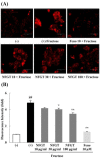Antihypertriglyceridemia activities of naturally fermented green tea, Heukcha, extract through modulation of lipid metabolism in rats fed a high-fructose diet
- PMID: 34868706
- PMCID: PMC8595438
- DOI: 10.1007/s10068-021-00992-y
Antihypertriglyceridemia activities of naturally fermented green tea, Heukcha, extract through modulation of lipid metabolism in rats fed a high-fructose diet
Abstract
Hypertriglyceridemia, a symptom of elevated triglyceride level in the blood, is a potent risk factor for cardiovascular and metabolic disorders. Among the numerous treatments to regulate circulating triglyceride levels, fibrates are widely used to treat hypertriglyceridemia, although they also have side effects such as hepatotoxicity and gallstone formation. In the present study, we aimed to investigate the blood triglyceride-lowering effects of a naturally fermented green tea extract (NFGT) and the underlying mechanisms on hypertriglyceridemia in vitro and in vivo models. NFGT suppressed the expression of lipogenic genes, while augmented expression of fatty acid oxidation-related genes in cultured cells, leading to the significant decrease of intracellular triglyceride content. NFGT treated group in fructose-induced hypertriglyceridemic rat model significantly decreased plasma and hepatic triglyceride, which was accompanied by an increase in excretion of fecal fat. Taken together, we propose that NFGT could be potentially a novel functional ingredient to prevent or treat hypertriglyceridemia.
Keywords: Hypertriglyceridemia; Lipid metabolism; Naturally fermented green tea; Pancreatic lipase.
© The Korean Society of Food Science and Technology 2021.
Conflict of interest statement
Conflict of interestThe author declares no conflicts of interest.
Figures






References
-
- Cai X, Hayashi S, Fang C, Hao S, Wang X, Nishiguchi S, Tsutsui H, Sheng J. Pu’erh tea extract-mediated protection against hepatosteatosis and insulin resistance in mice with diet-induced obesity is associated with the induction of de novo lipogenesis in visceral adipose tissue. Journal of Gastroenterology. 2017;52:1240–1251. doi: 10.1007/s00535-017-1332-3. - DOI - PubMed
LinkOut - more resources
Full Text Sources
